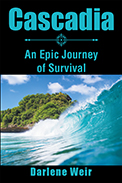
 |
Natural disasters are horrible. They are a tragic reminder that regardless of the progress that’s been made over the centuries, humankind is still no match for the volatility and violence of nature. However, they also remind us of the bravery, decency, and spirit which often shine brightest when times are dark. This novel is a testament to exceptional behavior in excruciating times.
A huge 9.0 earthquake rocks British Columbia along the west coast of Canada. The devastation is widespread. Cities, towns, villages, and neighborhoods find themselves literally falling to pieces as the earth gives way. One family, whose home actually crumbles around them, takes to a dinghy and makes a mad dash for the dock where they hope their sea-going vessel is still in one piece. What follows is a tale of desperation, danger, adventure, and adaptability as the multigenerational group battles the elements not just to stay together but also to stay alive. They encounter raging waters, wild animals, malevolent looters, and more, but their determination drives them forward.
The majority of Weir’s tale is told in the first person and in present-tense narration from Angie, the family’s thirteen-year-old daughter. This approach heightens intensity as the events unfold. It also grounds the story in a loving and hopeful point of view even as fear and uncertainty abound. The author paces her story well while introducing supporting characters that add involvement. Her action sequences are vivid and put the reader right in the middle of life and death situations. She’s also chosen to emphasize the collective nature of dealing with immense tragedy—people helping other people in dire straits. Doing so makes her novel one of selflessness as well as survival.